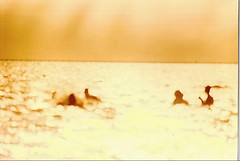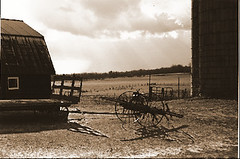Flags of Our Fathers (2006)
Dir. Clint Eastwood
Writ. Paul Haggis; James Bradley, novel
w/ Ryan Phillippe, Jesse Bradford, Adam Beach, Barry Pepper
In a breath-taking reinvention of the war film, Clint Eastwood’s Flags of Our Fathers depicts the less visible elements behind war through the experiences of three seeming heroes. Ryan Phillipe, Jesse Bradford, and Adam Beach re-enact the masquerade three soldiers are asked to perform after a prematurely victorious claiming of Iwo Jima ends with bloodshed. The snapshot of the event is sent back to the States for mass production where it becomes iconic overnight, spawning a false sense of closure. The shift in public perception as a result of the now-famous image tells the story of a war that bankrupted the treasury, forced the FDR administration to inflate the economy with freshly minted money, and brought three soldiers home to sell war bonds vis-à-vis their new glory.
Half-truths are the stuff of wars and Flags breaks no knuckles to dissemble that fact. The lies revolving around the three soldiers’ tour bear the burden of the story’s larger context, the reflection of war’s presumptive deceit. Emotions brought to heel by the scope of what each soldier has been through acts as the focal point for the film’s inter-cutting between the trenches of Iwo Jima and the anti-climactic stadium tours for the American public. Embodying the more frenetic emotions is Beach as the real-life Native American soldier Ira Hayes, who had wanted to stay on the front but gets shipped home for the war effort instead. Getting drunk night after night, Hayes spills their general reception to the horrors of public ignorance as much as, if not more than, the horrors of war.
And horror, precisely, informs Eastwood’s landscape, not action. By taking the verbal subtext of the standard war film format out, and replacing it with a suspenseful sense of the macabre, he has isolated war as singular acts and experiences with repercussions on a personal level that may not have been visually discussed before Flags. Soldiers crouch in pockets separated from their fellows with darkness, smoke, and distance. Guns emerge from Japanese turrets with painstaking separation from their unseen operators whose aim is uncertain but a sure and calculated defense against an overwhelming invading force.
That Eastwood never stoops to overwhelm with sheer numbers in battle, nor with epic CGI landscapes, credits the director’s intent and casts a quiet, new light on an already impressive and understated filmography. That’s not to say that Flags doesn’t employ effects where needed, nor that they aren’t magnificent when applied; but the focus remains on the inner turmoil and its translation to the audience member as a participant in a war that pulled attention in so many directions, in part to avoid facing the grim truth and the grimmer realities of World War II. America and the world have seen the bloody combat scenes time and time again in war films. Eastwood lays those impulses aside to set the tone and the space to go someplace new, unexplored, and ultimately languageless.
That undiscovered country will emerge of course in his follow-up segment, Letters from Iwo Jima, which will appear early next year from the Japanese viewpoint. A decidedly good and fresh idea, the echoes of the first installment should still be sounding softly by that time, a reminder that a new outlook on an old and still unresolved problem always exists in the eyes of the searching. My gut tells me that Letters should bring that home.















